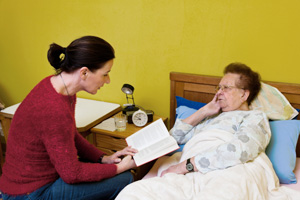Complementary Therapies Ease Stress For Hospice Patients And Caregivers
 Fear, worry and stress — byproducts of a life-threatening illness — can manifest themselves physiologically as anxiety, difficulty breathing and nausea. While traditional health care practices are used to treat the illness, complementary therapies including reflexology, massage, healing touch, bedside harp and aromatherapy can bring patients and their caregivers a sense of peace.
Fear, worry and stress — byproducts of a life-threatening illness — can manifest themselves physiologically as anxiety, difficulty breathing and nausea. While traditional health care practices are used to treat the illness, complementary therapies including reflexology, massage, healing touch, bedside harp and aromatherapy can bring patients and their caregivers a sense of peace.
With that philosophy and under the leadership of Valerie Hartman, a registered and certified hospice nurse and national proponent of complementary therapy and palliative care, Holy Redeemer Hospice has developed a complementary therapy program that is at the forefront of its field.
While other hospice programs offer some complementary therapies through volunteers, “We’re the only ones to have integrated [the therapies] into our hospice care program through the use of professional team members,” said Terre Mirsch, Holy Redeemer HomeCare and Hospice vice president. “We use a lot of reflexology and healing touch,” said Hartman, co-founder and coordinator of Holy Redeemer’s complementary therapy program.
Reflexology involves massage of the hands or feet that puts pressure on nerve endings to create a relaxed state, she said. Healing touch, in which the provider gently places their hands slightly above or on the fully clothed patient, is an energy-based therapy and holistic nursing practice that “creates a peaceful detached contemplative state — really deep relaxation.”
“It conveys a quiet, nurturing presence,” and for the frail elderly, who might not get a lot of nurturing touch, “massage can be very comforting and reassuring,” she said. The therapies are provided by trained hospice and palliative care nurses for specific goals: coping, symptom relief and symptom support, Hartman said.
Those in hospice can have high and sustained levels of fear and stress that can cause shortness of breath and nausea, she said, and their caregivers may suffer from sleeplessness, muscle aches and tension and anxiety. Complementary therapies can help the patient and caregiver cope with fear and stress and alleviate the symptoms caused by them, Hartman said.
Most Holy Redeemer hospice patients receive hospice care in their own homes and are being cared for by family, Mirsch said. “That’s why Valerie and her team being able to provide for caregivers is so important,” she said. “Caring for someone can be very stressful … and by alleviating their stress, they can provide the necessary care to their loved one.”
Complementary therapy is “not just a nice thing to do,” Hartman said. “A lot see it as pampering, but when it’s used along with nursing practices and you see the level of stress go down, you can see big changes for patients and caregivers.”
With four CTRNs certified in complementary therapy and palliative care providing services on a daily basis, Holy Redeemer’s hospice program can treat about 40 patients with high stress rather than only two to three a week, Hartman said. In addition, one of the four is certified in body work therapy and all CTRNs are certified in aromatherapy. Typically, a patient is seen once a week for a 30-minute therapy session, Hartman said.
Every hospice patient has a hospice nurse to coordinate care by the team, which includes a social worker and chaplain, Mirsch said. The nurse will make a referral to Hartman and her team to do an evaluation of the stress levels and symptoms being experienced and “what modality would best benefit the patient or caregiver.” Hartman said she measures stress levels “by what people say they are feeling,” and by facial grimace, rigidity and body tension, poor digestion and rapid, shallow breathing.
To measure the effect of the complementary therapies, “we look for nonverbal signs of stress and tension and at the end [of a therapy session] we see some relaxation and if they are able to speak to me they will verbally say it’s a great relief,” Hartman said. Studies are also being done to determine the efficacy of the therapies by measuring the amount of cortisol and adrenalin — stress hormones — in the blood stream, she said.
Stress is responsible for anxiety, tension and worry, and people may be in pain and feel nauseated, Hartman said. “When we finish working with someone, we provide that type of relief and comfort and that looks and feels a lot like peace,” she said. “That’s what the hospice team is trying to achieve and complementary therapy is a very important adjunct.”
Copyright © Linda Finarelli, Montgomery Media











